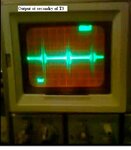froten
Member level 3
Hello all,
I have starting building the proto type of my receiver circuit. I started by the mixer+IF stage. Attached is the schematic, PCB (before modifications) and transformers details. The transformers are rewond of some old toko coils I have on hand.
The resulting circuis caused me many nightmares, it is oscillating, noisy and refuses to work for me.
Attached also is a picture of the output at detector D1. When I disconnect C13 & C19 oscillation stops, also if I lower the gain by adding un-bypassed resistor at the emitters the oscillation stops too.
Checked in many text books for solutions and techniques, found nuetralization techniques but none of them worked. For example, I tried to connecte a capacitors (ranging from 2pf to 47pf) from the pin 1 on T6, T5 & T3 to the base but still unstable, tried to use pin 3 for the same thing but still the same.
When I disconnect the stage of Q3, the oscillation stops.
What is going wrong with my design? This simple circuit I was thinking I will build during the week end, and it is now the fourth week without any success.
Any help is appreciated.
I have starting building the proto type of my receiver circuit. I started by the mixer+IF stage. Attached is the schematic, PCB (before modifications) and transformers details. The transformers are rewond of some old toko coils I have on hand.
The resulting circuis caused me many nightmares, it is oscillating, noisy and refuses to work for me.
Attached also is a picture of the output at detector D1. When I disconnect C13 & C19 oscillation stops, also if I lower the gain by adding un-bypassed resistor at the emitters the oscillation stops too.
Checked in many text books for solutions and techniques, found nuetralization techniques but none of them worked. For example, I tried to connecte a capacitors (ranging from 2pf to 47pf) from the pin 1 on T6, T5 & T3 to the base but still unstable, tried to use pin 3 for the same thing but still the same.
When I disconnect the stage of Q3, the oscillation stops.
What is going wrong with my design? This simple circuit I was thinking I will build during the week end, and it is now the fourth week without any success.
Any help is appreciated.



